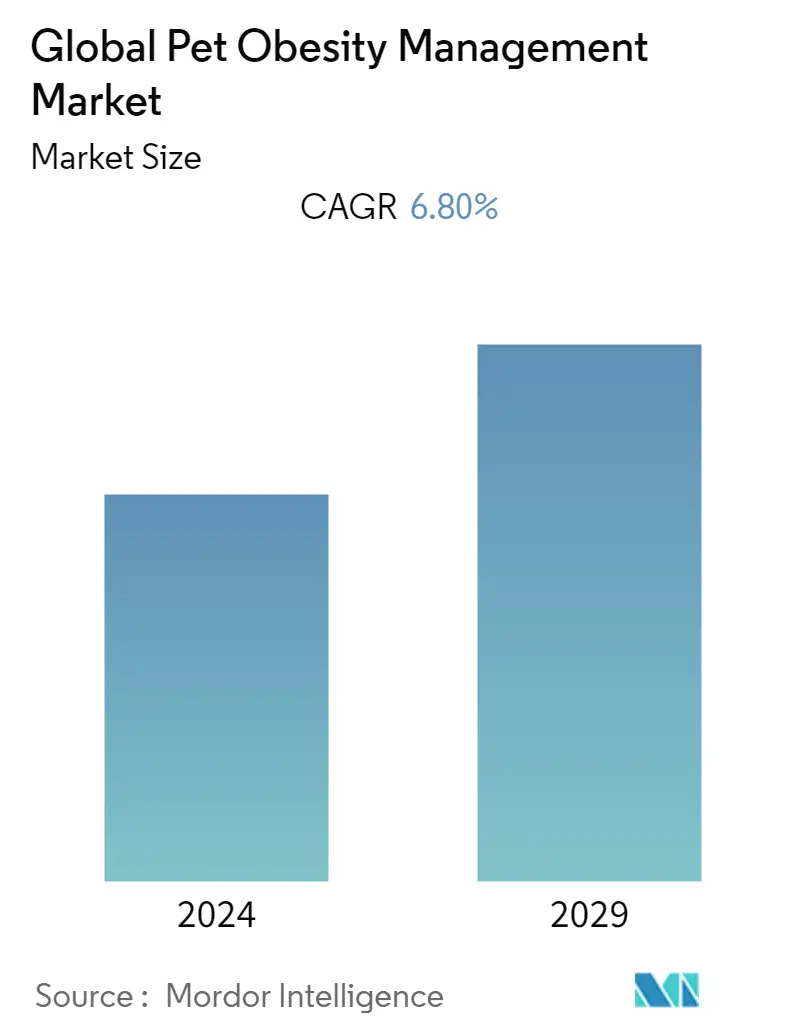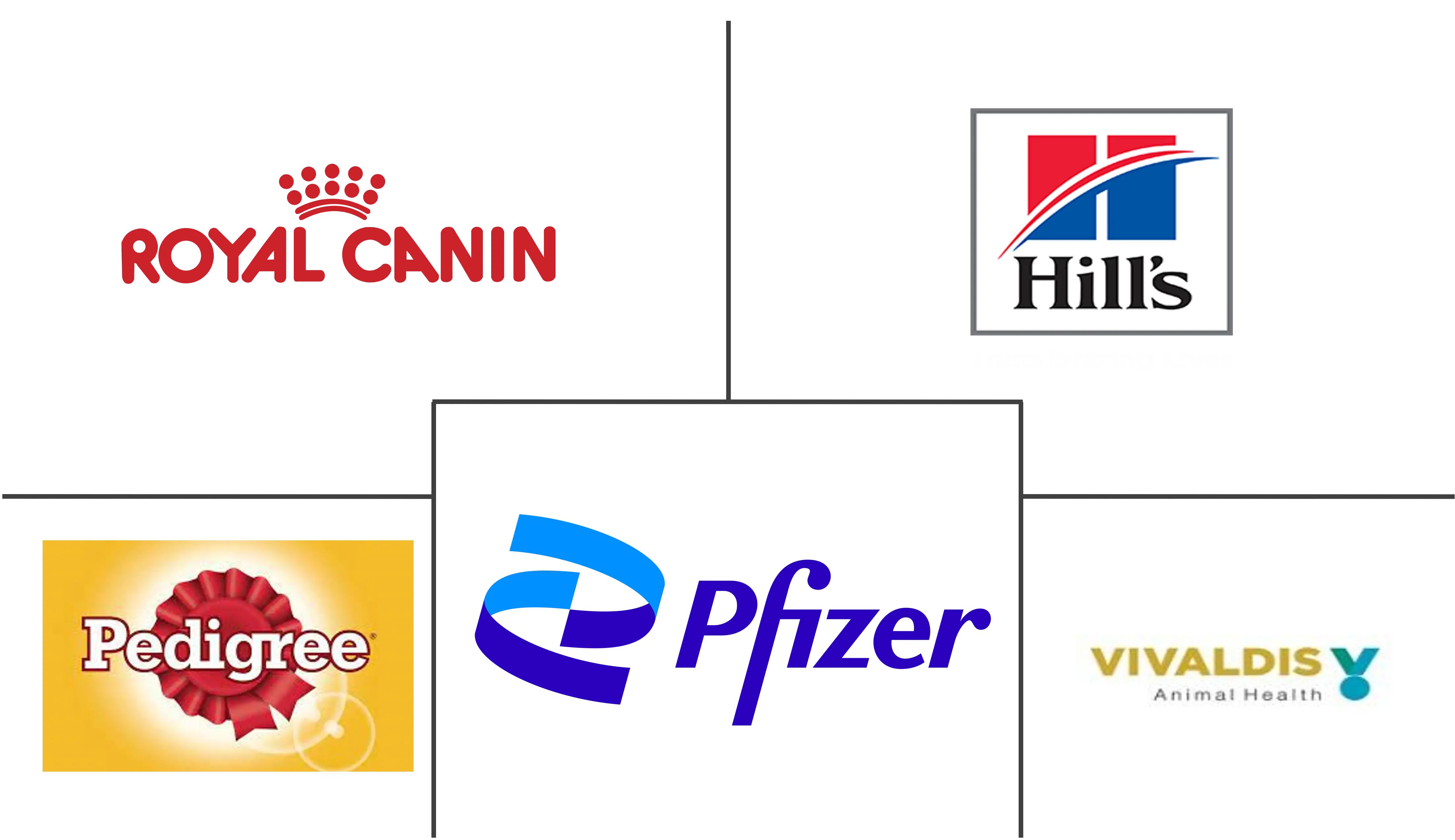Market Size of Global Pet Obesity Management Industry

| Study Period | 2021 - 2029 |
| Base Year For Estimation | 2023 |
| Forecast Data Period | 2024 - 2029 |
| CAGR | 6.80 % |
| Fastest Growing Market | Asia-Pacific |
| Largest Market | North America |
Major Players
*Disclaimer: Major Players sorted in no particular order |
Pet Obesity Management Market Analysis
The pet obesity management market is projected to register a CAGR of 6.80% during the forecast period.
While the COVID-19 pandemic greatly influenced human lifestyle, it also impacted the pets' food habits, activity levels, and weight, all of which significantly impacted the quality of life. According to the Windermere Veterinary Services report published in June 2021, overweight pets climbed by 108% till 2020. As per the Washington Post published in January 2022, Americans spent USD 21.4 billion on nonmedical pet products through November 2020. As per an article published in August 2021, by the People's Dispensary for Sick Animals, pups were being walked less frequently than pre-pandemic, with 38% leaving the house just once a day compared to 33% in February 2020 due to the lockdown. Hence, the COVID-19 pandemic has elevated obesity levels among pets, significantly contributing to the market's growth.
According to an article published by Pet Keen in July 2022, vets estimate that as many as 59% of all pets are obese. Over the past 10 years, there has been a 169% increase in overweight cats and a 158% increase in overweight dogs. As per the same source, as many as 37% of all dogs are overweight by the time they are six months old. The obesity epidemic is also affecting pets in developing nations, with 44% of all canines in China being classified as obese. As a result of the rising prevalence of pet obesity, pet obesity management strategies are becoming more widely adopted.
The increasing adoption of pets worldwide is expected to boost the market's growth over the forecast period. For instance, according to the American Pet Products Association's (APPA) National Pet Owners Survey of 2021-2022, 70% of American homes, or about 90.5 million families, owned a pet. The increased ownership of pets and per capita earnings among individuals, particularly in developing nations, will likely fuel this market's expansion. According to the North American Pet Health Insurance Association (NAPHIA), gross written premiums for pet health insurance in the United States reached USD 1.99 billion in 2020, an increase of 27.5% from USD 1.56 billion in 2019. From 2016 to 2020, the market grew at an annual rate of around 24.2%. Hence, this is likely to contribute to the market's growth.
Many pet owners are aware of and worried about maintaining their pets' weight, particularly in the early stages, as excess weight can lead to various health problems. If left unchecked, it can lead to astronomically high medical expenditures. Increased occurrences of obesity-related disorders in pets are predicted to increase the demand for pet obesity management, thereby contributing to the market's growth. However, a lack of awareness about pet obesity management in developing economies is expected to hinder the market's growth.
Pet Obesity Management Industry Segmentation
As per the scope of this report, obesity in pets occurs when excessive adipose tissue accumulates in the body. Pets are considered overweight when they weigh 10-30% above their ideal body weight.
The pet obesity management market is segmented by product (drugs and food supplements), animal type (dogs, cats, and other animals), end user (pet specialty stores, e-commerce, and other end users), and geography (North America, Europe, Asia-Pacific, Middle East and Africa, and South America). The market report also covers the estimated market sizes and trends for 17 countries across major global regions. The report offers the value (in USD million) for the above segments.
| By Products | |
| Drugs | |
| Food Supplements |
| By Animal Type | |
| Dogs | |
| Cats | |
| Other Animals |
| By End User | |
| Pet Specialty Stores | |
| E-commerce | |
| Other End Users |
| By Geography | ||||||||
| ||||||||
| ||||||||
| ||||||||
| ||||||||
|
Global Pet Obesity Management Market Size Summary
The pet obesity management market is experiencing significant growth, driven by increasing pet ownership and rising awareness of pet health issues. The COVID-19 pandemic has exacerbated pet obesity due to changes in pet activity levels and feeding habits, leading to a higher demand for obesity management solutions. The market is characterized by a growing prevalence of obesity among pets, with a notable increase in overweight dogs and cats. This trend is not limited to developed countries; developing nations are also witnessing a rise in pet obesity, prompting the adoption of management strategies. The market's expansion is further supported by the increasing availability of specialized nutritional products and the introduction of innovative weight management solutions by key industry players.
North America is anticipated to hold a significant share of the pet obesity management market, fueled by concerns over pet health and the availability of pet insurance policies that cover obesity-related conditions. The region's market growth is also supported by the rising incidence of obesity in pets, which has led to a surge in demand for effective weight control programs. Major companies in the market are focusing on product development and expanding distribution channels to capture a larger market share. The competitive landscape is fragmented, with several key players dominating the market. These companies are actively engaging in campaigns and partnerships to raise awareness about pet obesity and promote their products, contributing to the overall growth of the market.
Global Pet Obesity Management Market Size - Table of Contents
-
1. MARKET DYNAMICS
-
1.1 Market Overview
-
1.2 Market Drivers
-
1.2.1 Increasing Pet Ownership
-
1.2.2 Increasing Prevalence of Diabetes and Other Chronic Diseases Among Pets
-
1.2.3 Increasing Pet Insurance Policies and Coverage
-
-
1.3 Market Restraints
-
1.3.1 Lack of Awareness About Pet Obesity Management in Developing Economies
-
-
1.4 Porter's Five Forces Analysis
-
1.4.1 Threat of New Entrants
-
1.4.2 Bargaining Power of Buyers/Consumers
-
1.4.3 Bargaining Power of Suppliers
-
1.4.4 Threat of Substitute Products
-
1.4.5 Intensity of Competitive Rivalry
-
-
-
2. MARKET SEGMENTATION (Market Size by Value - USD million)
-
2.1 By Products
-
2.1.1 Drugs
-
2.1.2 Food Supplements
-
-
2.2 By Animal Type
-
2.2.1 Dogs
-
2.2.2 Cats
-
2.2.3 Other Animals
-
-
2.3 By End User
-
2.3.1 Pet Specialty Stores
-
2.3.2 E-commerce
-
2.3.3 Other End Users
-
-
2.4 By Geography
-
2.4.1 North America
-
2.4.1.1 United States
-
2.4.1.2 Canada
-
2.4.1.3 Mexico
-
-
2.4.2 Europe
-
2.4.2.1 Germany
-
2.4.2.2 United Kingdom
-
2.4.2.3 France
-
2.4.2.4 Italy
-
2.4.2.5 Spain
-
2.4.2.6 Rest of Europe
-
-
2.4.3 Asia-Pacific
-
2.4.3.1 China
-
2.4.3.2 Japan
-
2.4.3.3 India
-
2.4.3.4 Australia
-
2.4.3.5 South Korea
-
2.4.3.6 Rest of Asia-Pacific
-
-
2.4.4 Middle East and Africa
-
2.4.4.1 GCC
-
2.4.4.2 South Africa
-
2.4.4.3 Rest of Middle East and Africa
-
-
2.4.5 South America
-
2.4.5.1 Brazil
-
2.4.5.2 Argentina
-
2.4.5.3 Rest of South America
-
-
-
Global Pet Obesity Management Market Size FAQs
What is the current Global Pet Obesity Management Market size?
The Global Pet Obesity Management Market is projected to register a CAGR of 6.80% during the forecast period (2024-2029)
Who are the key players in Global Pet Obesity Management Market?
Royal Canin, Hills Pet Nutrition, Inc., Pedigree, Pfizer animal health and Vivaldis are the major companies operating in the Global Pet Obesity Management Market.

